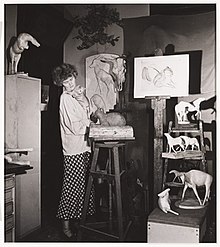Rhys Caparn | |
|---|---|
 Rhys Caparn, in studio, 1948 | |
| Born | July 28, 1909 Onteora, New York |
| Died | April 29, 1997 (aged 87) |
| Known for | Artist |
Rhys Caparn (1909–1997) was an American sculptor known for her animal, landscape, and architectural subjects. Her works were mostly abstract but based on natural forms. In many of them she employed free lines and used a restrained style that nonetheless conveyed what critics saw as an emotional charge.[1][2] In the animal sculptures for which she became best known, she achieved what a critic called "a graceful curvilinear balance."[3] Another critic put this aspect of her style in terms of the arch of a cat's back in one of her pieces: "A cat's arched back is a pleasingly rounded shape and well balanced on the foundation of paws. But it is still a cat's back, embodying a cat's peculiar physical response to fear or affection."[2] Her foundational influences included an ancient Greek statue and the abstract works of Constantin Brancusi. From her most prominent instructor, Alexander Archipenko, she said she learned to seek out the underlying ideal in a natural form, the point at which "form and idea become one."[4] Her works were mostly small and almost all made by modeling.
She received her training in Paris and New York. With the support of her parents and two wealthy widows, she was able to devote her time to study and creative work and her sculptures made an immediate impact when first shown in the early 1930s. Throughout the rest of her long career, she exhibited frequently in commercial galleries, museums, and the shows of the nonprofit associations of which she was a member. She helped to form the Federation of Modern Painters and Sculptors in 1940 and thereafter served as one of its leaders. In the 1940s and 1950s, she taught sculpture classes two days a week at the Dalton School in Manhattan. She won a prestigious and controversial award from the Metropolitan Museum of Art in 1951. She died of Alzheimer's disease in 1997.
- ^ Cite error: The named reference
New York Sun Nov 1933was invoked but never defined (see the help page). - ^ a b Cite error: The named reference
New York Times Nov 1959was invoked but never defined (see the help page). - ^ Cite error: The named reference
New York Times Nov 1935was invoked but never defined (see the help page). - ^ Cite error: The named reference
Women Artists 2013was invoked but never defined (see the help page).